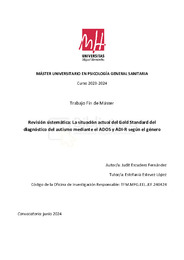Please use this identifier to cite or link to this item:
https://hdl.handle.net/11000/33986Full metadata record
| DC Field | Value | Language |
|---|---|---|
| dc.contributor.advisor | Estévez López, Estefanía | - |
| dc.contributor.author | Escudero Fernández, Judit | - |
| dc.contributor.other | Departamentos de la UMH::Psicología de la Salud | es_ES |
| dc.date.accessioned | 2024-11-21T13:50:04Z | - |
| dc.date.available | 2024-11-21T13:50:04Z | - |
| dc.date.created | 2024-06 | - |
| dc.identifier.uri | https://hdl.handle.net/11000/33986 | - |
| dc.description.abstract | Actualmente el diagnóstico de personas dentro del espectro autista se realiza mediante dos herramientas consideradas como el Gold standard de evaluación: el ADOS y su versión más reciente ADOS-II y el ADI-R. Sin embargo, existe controversia acerca de si cubren con las necesidades de toda la población del espectro, incluyendo a personas con trastornos de personalidad como falsos positivos o excluyendo a parte de la población femenina, niños muy pequeños, aquellos con un fenotipo grave con discapacidad intelectual o de diferentes culturas (Frigaux et al., 2019). Esto puede ocasionar que se demore el diagnóstico de estas personas (Fusar-Poli et al., 2022; Paolizzi et al., 2022; Stroth et al., 2022) o se le diagnostique de otros trastornos mentales antes del diagnóstico de TEA (Tien et al., 2023). En el caso de las mujeres, se ha establecido un fenotipo diferente al masculino (Beggiato et al., 2017; Tillman et al., 2018), cuyas conclusiones se detallarán en la presente investigación. De esta forma, este estudio pretende realizar una revisión entre los artículos de los últimos años de distintas bases de datos: Pubmed, Science Direct, PsycInfo y Scopus sobre el diagnóstico del fenotipo femenino y sus estrategias de camuflaje mediante los instrumentos mencionados anteriormente, para establecer si constituyen un buen ratio de diagnóstico en esta población y qué cosas se deben tener en cuenta para las siguientes actualizaciones de las herramientas diagnósticas. | es_ES |
| dc.description.abstract | Nowadays, the diagnosis of individuals classified as autistic is performed using two tools considered as the Gold standard of evaluation: the ADOS and its most recent version ADOS-II and the ADI-R. However, there is some controversy about whether they meet the needs of the entire population spectrum, including people with personality disorders as false positives or excluding part of the female population, very young children, those with a severe phenotype with intellectual disability or from different cultures (Frigaux et al., 2019). This may result in a delayed diagnosis for these individuals (Fusar-Poli et al., 2022; Paolizzi et al., 2022; Stroth et al., 2022) or being diagnosed with other mental disorders before the diagnosis of ASD (Tien et al., 2023). For females, a different phenotype than males has been established (Beggiato et al., 2017; Tillman et al., 2018), the findings of that phenotype will be detailed in the present research. Thus, this study aims to perform a review among articles from recent years from different databases: Pubmed, Science Direct, PsycInfo and Scopus on the diagnosis of the female phenotype and its camouflage strategies using the mentioned tools above, in order to establish if they constitute a good diagnostic ratio in this population and what things should be taken into account for the following updates of the diagnostic tools. | es_ES |
| dc.format | application/pdf | es_ES |
| dc.format.extent | 35 | es_ES |
| dc.language.iso | spa | es_ES |
| dc.publisher | Universidad Miguel Hérnández de Elche | es_ES |
| dc.rights | info:eu-repo/semantics/openAccess | es_ES |
| dc.rights | Attribution-NonCommercial-NoDerivatives 4.0 Internacional | * |
| dc.rights.uri | http://creativecommons.org/licenses/by-nc-nd/4.0/ | * |
| dc.subject | Autismo | es_ES |
| dc.subject | ADOS | es_ES |
| dc.subject | ADI-R | es_ES |
| dc.subject | Fenotipo femenino | es_ES |
| dc.subject | Camuflaje | es_ES |
| dc.subject.other | CDU::1 - Filosofía y psicología::159.9 - Psicología | es_ES |
| dc.title | Revisión sistemática: La situación actual del Gold Standard del diagnóstico del autismo mediante el ADOS y ADI-R según el género | es_ES |
| dc.type | info:eu-repo/semantics/masterThesis | es_ES |

View/Open:
ESCUDERO TFM.pdf
992,07 kB
Adobe PDF
Share:
.png)
